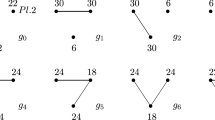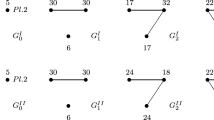Abstract
I consider situations in which a group of players extracts a value if they organise themselves in different network structures, and I define a solution concept to describe the decentralised decision that determines the network formation process and the allocation of the value. I demonstrate that there is a solution concept satisfying discounted expected versions of pairwise stability (Jackson and Wolinsky J Econ Theory 71:44–74, 1996) and fairness (Myerson Math Oper Res 2:225–229, 1977a) jointly with the requirement that the allocation rule be component efficient if the players’ discount factor is sufficiently low.



Similar content being viewed by others
Notes
See Jackson (2008, Chap. 6).
Jackson (2005, p. 130) discusses how the possibilities that players face under alternative networks should shape the way in which the value will be allocated.
A component is a group of players that is internally connected but is disconnected from the rest of the players.
Jackson and Wolinsky (1996) call this property equal bargaining power.
The most famous reference is Rawls (1971).
See Jackson (2005) for a more detail critique.
Pairwise stability is a specific transformation rule governing transitions from one network structure to another.
\((I-\delta P)\) has an inverse provided that \(1/\delta \) is not an eigenvalue of the matrix \(P\). Any transition probability matrix such as \(P\) has eigenvalues smaller than or equal to 1, which implies that \(1/\delta \), being greater than 1, cannot be an eigenvalue of \(P\).
A closed cycle of graphs is defined as follows. Given a transition probability matrix \(P\), a set of graphs \(C=\left\{ g_1,g_2,..., g_R\right\} \subseteq G\) is a cycle of graphs if \(P\left( g_{2}|g_{1}\right) > 0\), \(P\left( g_{3}|g_{2}\right) > 0\), ..., \( P\left( g_{R}|g_{R-1}\right) > 0\) and \(P\left( g_{1}|g_{R}\right) > 0\). A cycle of graphs is a closed cycle if, beginning at any graph in the cycle, the process remains within the cycle with probability 1.
More specifically, the order is defined as top left to top right first and bottom left to bottom right afterwards. This means that first row and column of the transition probability matrix correspond to the complete graph, the second row and column correspond to the graph where players \(1\) and \(2\) are both directly connected to \(3\), and so on. The last row and column then correspond to the empty graph.
Note that A is the inverse of difference A above, as the transition that takes place is in the opposite direction.
The product of a real number multiplied by an allocation rule is equivalent to the product of a real number multiplied by a vectorial function, and the sum of two allocation rules is equivalent to the sum of two vectorial functions with equal dimensions.
Note that because the matrix \(M_P\) is not symmetric, its eigenvalues are not necessarily real numbers.
References
Currarini S, Morelli M (2000) Network formation with sequential demands. Rev Econ Design 5:229–249
Dutta B, Ghosal S, Ray D (2005) Farsighted network formation. J Econ Theory 122:143–164
Easley D, Kleinberg J (2010) Networks, crowds, and markets: reasoning in a highly connected world. Cambridge University Press, Cambridge
Feldman BE (1996) Bargaining, coalition formation, and value. Ph.D. Dissertation, State University of New York at Stony Brook
Goyal S (2007) Connections: an introduction to the economics of networks. Princeton University Press, Princeton
Herings PJ-J, Mauleon A, Vannetelbosch V (2009) Farsightedly stable networks. Games Econ Behav 67:526–541
Jackson MO (2005) Allocation rules for network games. Games Econ Behav 51:128–154
Jackson MO (2008) Social and economic networks. Princeton University Press, Princeton
Jackson MO, Watts A (2002) The evolution of social and economic networks. J Econ Theory 106:265–295
Jackson MO, Wolinsky A (1996) A strategic model of social and economic networks. J Econ Theory 71:44–74
Myerson RB (1977a) Graphs and cooperation in games. Math Oper Res 2:225–229
Myerson RB (1977b) Values of games in partition function form. Int J Game Theory 6:23–31
Navarro N (2007) Fair allocation in networks with externalities. Games Econ Behav 58:354–364
Navarro N (2010) Flexible network rules for identified externalities. Games Econ Behav 69:401–410
Page FP Jr, Wooders MH, Kamat S (2005) Networks and farsighted stability. J Econ Theory 120:257–269
Rawls J (1971) A theory of justice. Harvard University Press, Cambridge
Slikker M, van den Nouweland A (2000) A one stage model of link formation and payoff division. Games Econ Behav 34:153–175
Acknowledgments
I thank my PhD supervisor, Andrés Perea, for his constant support and assistance. Further comments from an anonymous referee and an associate editor, and financial support from the Spanish Ministry of Science and Innovation ECO2011-29355 are also acknowledged. All errors are mine.
Author information
Authors and Affiliations
Corresponding author
Rights and permissions
About this article
Cite this article
Navarro, N. Expected fair allocation in farsighted network formation. Soc Choice Welf 43, 287–308 (2014). https://doi.org/10.1007/s00355-013-0777-4
Received:
Accepted:
Published:
Issue Date:
DOI: https://doi.org/10.1007/s00355-013-0777-4




